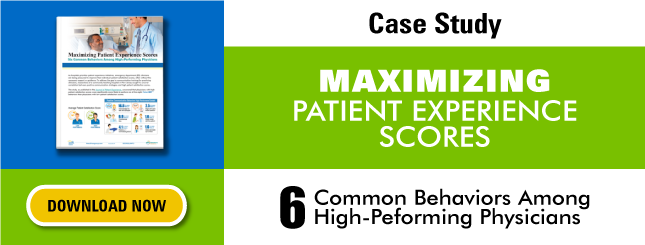 [4 MIN READ]
[4 MIN READ]
All of us experience a never-ending number of first impressions.
Consider that first visit to a restaurant that was highly recommended by friends. After being seated, five or ten minutes go by without a server coming to the table. When the server finally arrives, they seem distracted with no discernible facial expression. How does this indifference make you feel?
Or what about the flight attendant who treats you like an empty seat when you try to ask a simple question?
In either case, the chance for a warm, enjoyable experience is diminished after such a cold beginning.
The same is true for patients in their initial encounter with healthcare providers, whether they’re physicians, nurses or other personnel.
The first impression is established from the first moments of contact and will dictate the perceived quality of the overall experience.
In the TSG PatientSET® communication program, the patient’s first impression is the critical initial step. In our research of initial impressions, all the first impression behaviors below (except Pause and Introduce) were observed to occur significantly more in providers with high patient satisfaction scores compared to their peers with low patient satisfaction scores.
Let’s take a look at several elements that must be present to create a positive patient experience:
Pause.As professionals, we understand that we rarely have the luxury of too much time. The daily rush and the stress that accompanies it convey additional stress to the patient, who is most likely already ill at ease. As a result, rushing into the examination room is counterproductive. The solution: Take a brief pause (or deep breath) before entering. This effort will help to both clear your head and relax the patient.Smile and Make Eye Contact.Nothing relaxes a person better than a warm smile. When combined with direct eye contact, you immediately demonstrate a sincere welcome and a willingness to help resolve a health problem.Introduce Yourself.Many provider/patient encounters are between strangers, so this simple technique introduces a personal element that might have been missing previously. It’s no different than what a good server or salesperson would do.Appropriate Touch.Patients often require reassurance that providers recognize their anxiety about a medical condition. When culturally acceptable, a gentle touch on the arm or a pat on the shoulder can deliver a silent but effective message that you understand their concerns.Acknowledge the Wait and Apologize.Patients often wait longer than they would have preferred. These delays are not normally the fault of the healthcare provider, but that doesn’t matter to the patient. Take the opportunity to let them know you are sorry for their wait. This shows them you are on their side; it defuses an issue that most likely was not your fault; and it can go a long way toward building your relationship with them.Begin with an Open-Ended Question.Begin with a question like, “How Can I Help You?” Don’t assume any medical condition, even if you’ve had the benefit of looking at a chart or speaking with someone else before entering the examination room. Asking this open-ended question lets the patient explain the purpose of their visit in their own words. You just might learn some additional information that proves valuable in your diagnosis or treatment.Do At Least One Non-Medical Gesture.Take a moment to ask the patient if they are comfortable. Do they need a pillow, a blanket, or anything else? You can even show them how to adjust the stretcher to demonstrate that you are sincere in providing comfort to them.Overestimate Time.If additional testing is required, don’t negate all the good you may have accomplished with the previous elements by making unrealistic estimates of how long the tests will take. In fact, estimate more time than you think they will take by approximately 25%. This is a principle used at Disney and other service industries. And reassure the patient that the tests are necessary to provide the best information possible to treat their condition.
In reviewing all these elements that help create an excellent first impression, it may be tempting to only use two or three of them to achieve improvement.
While this strategy might be somewhat helpful, optimal results will only be realized by employing as many elements as possible to create the best overall experience for the patient, as the providers with high patient satisfaction scores did in our study.
As a final thought, practitioners, nurses and office personnel may feel that these communication methods will take them additional time in an already busy workplace environment or that their own personality doesn’t allow them to use these techniques. It is surprising how little time these communication techniques take since they focus on better, quality time and do not necessarily add more time to the patient encounter.
Regarding individual personalities, it can be more difficult for some individuals to master these techniques. But our experience has shown that those who are willing to make the effort will be very successful.
Patients’ surveys tell us there is a significant need for improvement in their healthcare experience. It is vital that we modify some of our traditional habits to make this a reality for our patients.
Interested in learning more for CME?
Review our courses:
- PatientSET™: Hospital Best Practice High-Risk Video
- PatientSET™: Introduction for All Healthcare Providers


